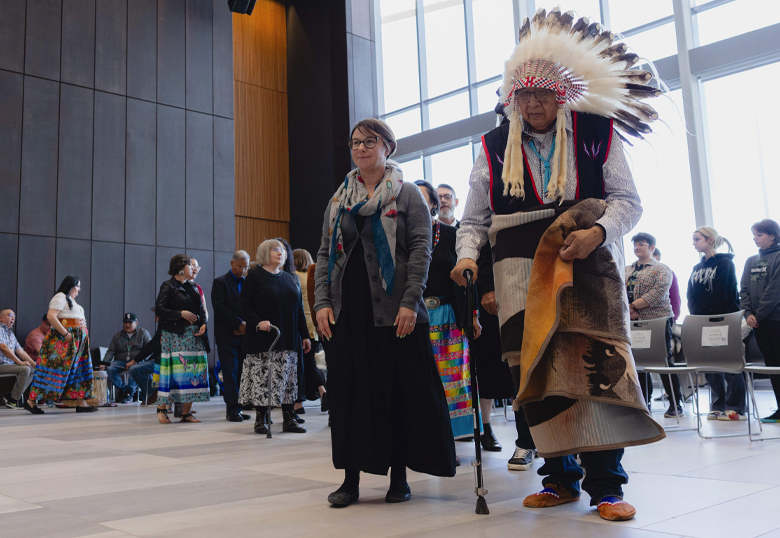Bearing a commitment to further the work being done to advance reconciliation and Indigenization at the University of Lethbridge, the Faculty of Fine Arts has been gifted a Blackfoot name – Piiksinaasin – by Iikaisskini (Low Horn) Dr. Leroy Little Bear (BASc (BA) ’72, DASc ’04).
The name was gifted as part of the opening ceremony for the 2024 Indigenous Awareness Week at ULethbridge on March 11.

Piiksinaasin, which means Manifesting Beauty, represents the Faculty of Fine Arts as a place where students create, explore and research, transforming the world around them through creative practice and critical thinking. The name reflects the Faculty’s long-standing support of Indigenous arts and creative initiatives and exemplifies the work done to advance reconciliation and decolonization.
Little Bear was joined by Ninnaisipistoo (Owl Chief) Elder Francis First Charger during the ceremony to gift the name, who spoke on the importance of fine arts for Indigenous Peoples.
“In many Indigenous communities, art is very much a part of our ways. It’s on the rocks, it’s on our tipis, each one with their own meaning. Each one of those arts has a name, there’s a story behind it.”
Dean of the Faculty of Fine Arts, Dr. Heather Davis-Fisch, says receiving a Blackfoot name gives the Faculty the important and ongoing responsibility of serving Indigenous students and the Blackfoot community, and allows the Faculty of Fine Arts to reflect on the work that has been done to support Indigenization.
“I am grateful to my colleagues and predecessors for beginning this important work and to our Elders and Advisors for teaching us how to do the work in a good way. Being gifted a Blackfoot name by Dr. Little Bear also comes with the responsibilities of promoting truth and reconciliation, incorporating decolonial practices in our teaching and learning and actively creating space for Indigenous resurgence and cultural revitalization.”
Fine Arts has been an integral part of the University of Lethbridge since the institution’s beginnings in 1967, with fervent faculty and student engagement that worked to improve the quality of the fine arts in Lethbridge and throughout the southern Alberta area. The Faculty of Fine Arts houses departments in art, drama, music and new media. With a focus on creative innovation, professional excellence and liberal education, it aims to inspire an imaginative, intellectual culture at the University and in the community.
Dedicated to reconciliation and Indigenization, the Faculty offers unique degree programs in Indigenous Art Studio and Art History/Museum Studies and supports research in Indigenous creative arts, including a Canada Research Chair in Indigenous Music, Culture and Politics, and a previous Canada Research Chair in Indigenous Arts and Technology.
Notably, the Department of Drama recently collaborated with the Making Treaty 7 Cultural Society on Yisstsiiyi, a historic production for both Fine Arts and ULethbridge, as it was the first Indigenous-led, created and directed Mainstage production, which featured alum Marshall Vielle (BFA - Dramatic Arts ’17) at the helm.
Now bestowed a Blackfoot name, the Faculty of Fine Arts has a duty to honour the name through continued support for Indigenization in the creative arts and reconciliation. For Davis-Fisch, she sees this as an opportunity to enhance current learning opportunities offered by Fine Arts and purposefully build tenets of Indigenous Ways of Knowing and Being into the Faculty’s strategic plan.
“Being gifted the name Piiksinaasin speaks to the Faculty’s long-standing relationships with the Blackfoot community and with Indigenous artists and knowledge keepers,” says Davis-Fisch. “Going forward, I am excited to contribute to the important work of infusing Indigenous ways of knowing and being across our curriculum, programs and activities by working in relationship with Indigenous students and community.”
